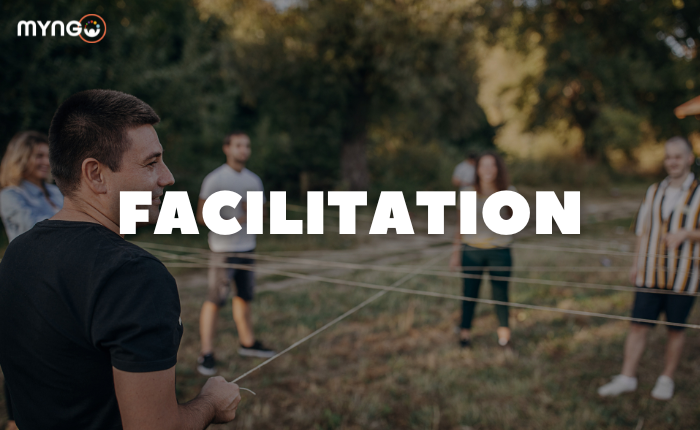
Welcome to Lesson 4!
In this lesson, we will explore the essential techniques for effectively facilitating and implementing team-building activities. Facilitating these activities requires a combination of strong leadership, adaptability, and the ability to create a positive environment. You will learn how to encourage active participation, address challenges, manage group dynamics, and conduct a thorough debriefing phase to evaluate the activity and reinforce learning outcomes.
Learning Objectives
- Understand techniques for facilitating effective team-building activities.
- Create a positive and supportive environment for participants.
- Encourage active participation and engagement.
- Address challenges and manage group dynamics.
- Conduct a debriefing phase to evaluate the activity and reinforce learning outcomes.
Lesson Content
Techniques for Facilitating Effective Team-Building Activities
Facilitating team-building activities involves guiding participants through the process, ensuring they stay engaged and focused, and helping them achieve the activity’s objectives. Effective facilitators use various techniques to create a dynamic and inclusive environment.
Key Techniques
- Clear Instructions: Provide clear and concise instructions to ensure participants understand the activity and their roles.
- Active Listening: Pay attention to participants’ feedback and reactions, showing that you value their input.
- Encouragement: Motivate participants by recognizing their efforts and celebrating successes.
- Flexibility: Be prepared to adapt the activity based on participants’ needs and dynamics.
Example
During a trust-building exercise, the facilitator might start by clearly explaining the activity’s purpose and steps. As the activity progresses, they listen to participants’ concerns, provide encouragement, and make adjustments if any participants feel uncomfortable.
Creating a Positive and Supportive Environment
A positive and supportive environment is crucial for the success of team-building activities. Participants are more likely to engage fully and benefit from the experience when they feel safe, respected, and valued.
Strategies to Create a Supportive Environment
- Establish Ground Rules: Set expectations for respectful behavior, active participation, and open communication.
- Foster Inclusivity: Ensure that all participants feel included and valued, regardless of their background or abilities.
- Model Positive Behavior: Demonstrate the attitudes and behaviors you want participants to adopt.
Example
Before starting a problem-solving activity, the facilitator might establish ground rules emphasizing respect and active listening. Throughout the activity, they model these behaviors, ensuring that all voices are heard and valued.
Encouraging Active Participation and Engagement
Active participation is key to the success of team-building activities. Facilitators should use techniques to engage all participants, making the activity enjoyable and impactful.
Techniques for Encouraging Participation
- Interactive Elements: Incorporate interactive and hands-on elements to keep participants engaged.
- Varied Activities: Use a mix of activities to cater to different learning styles and interests.
- Positive Reinforcement: Recognize and reward active participation to encourage ongoing engagement.
Example
In a team scavenger hunt, the facilitator might use interactive clues and puzzles that require participants to work together actively. They could also offer small rewards for completing tasks to maintain enthusiasm and motivation.
Addressing Challenges and Managing Group Dynamics
Facilitating team-building activities can come with challenges, such as managing diverse group dynamics, addressing conflicts, and keeping participants focused.
Strategies for Managing Challenges
- Conflict Resolution: Use conflict resolution techniques to address disagreements and ensure a positive atmosphere.
- Flexibility: Be prepared to adjust the activity if participants are struggling or if the dynamics are not working as expected.
- Focus on Goals: Remind participants of the activity’s goals to keep them focused and motivated.
Example
During a collaborative project, if two participants have a disagreement, the facilitator might step in to mediate, helping them find a resolution and reminding them of the shared goals.
Monitoring Progress and Adapting Facilitation Strategies as Needed
Effective facilitators continuously monitor the activity’s progress, making adjustments as needed to ensure participants stay engaged and on track.
Monitoring Techniques
- Observation: Watch participants’ interactions and engagement levels to gauge how well the activity is progressing.
- Feedback: Ask participants for feedback during the activity to identify any issues or areas for improvement.
- Adaptability: Be ready to modify the activity based on participants’ needs and feedback.
Example
If the facilitator notices that participants are losing interest during a long activity, they might introduce a quick, energizing game to re-engage the group before continuing with the main activity.
Debriefing Phase
The debriefing phase is a critical component of team-building activities, providing an opportunity for reflection, evaluation, and reinforcement of learning outcomes.
Steps in the Debriefing Phase
- Reflection: Encourage participants to reflect on their experiences and share their thoughts and feelings.
- Discussion: Facilitate a group discussion to explore what worked well, what challenges were faced, and what could be improved.
- Learning Outcomes: Reinforce the key learning outcomes of the activity and discuss how these can be applied in real-life situations.
- Feedback: Collect feedback from participants to improve future activities.
Example
After a teamwork exercise, the facilitator might gather the group for a debriefing session. They could ask questions like, “What did you learn about communication in this activity?” and “How can we apply these lessons in our daily work?”
Debriefing Questions
- What were the key takeaways from this activity?
- How did the activity help improve team dynamics?
- What challenges did you face, and how did you overcome them?
- How can the skills learned in this activity be applied in future projects?
Additional Resources
- “The Art of Facilitation” (PDF) by Robert Gass. A detailed guide on effective facilitation techniques and managing group dynamics.
- Digital Tools:
- Mentimeter: For interactive polls and quizzes to engage participants.
- Padlet: For collaborative brainstorming and idea-sharing.
- Zoom: For virtual facilitation, including breakout rooms for small group discussions.